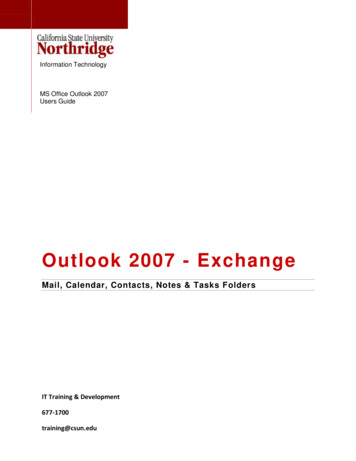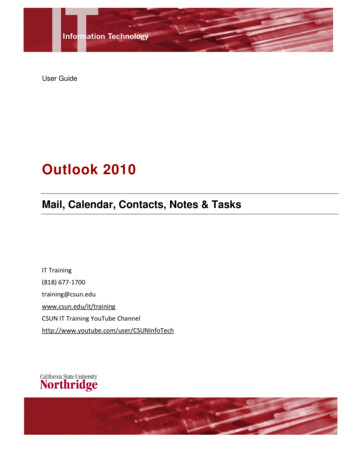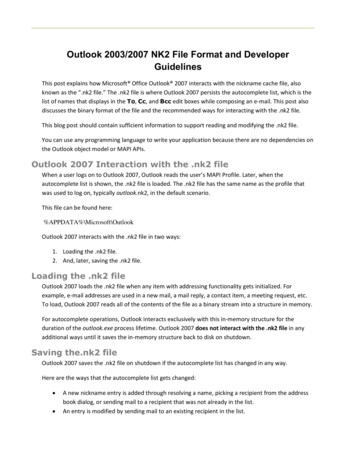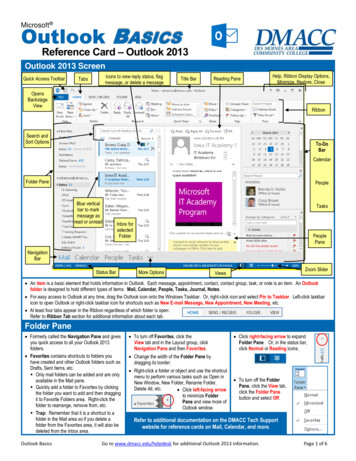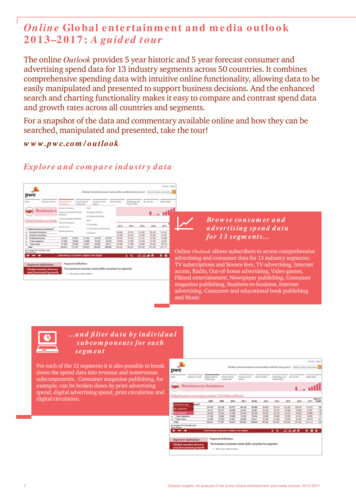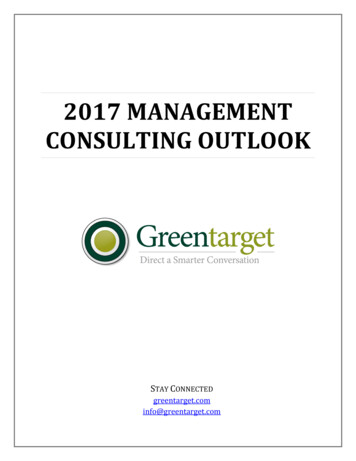
Transcription
2018Legal IndustryOutlook
Table of ContentsOverview. 2State of the Legal Market in 2018 And Beyond. 3Slow Growth. 3Fierce Competition. 4Consolidation . 5Growth and Challenge Areas . 6The New Operating Environment . 6Triple Aim: Productivity, Efficiency and Margin. 7The Talent Conundrum . 9Addressing Underperforming Lawyers . 9Slowdown in Lateral Hiring . 9New Staffing Models – Contract Lawyers, Professional Staff and Outsourcing . 10Succession Planning And Retaining Top Talent Paramount . 11Diversity at the Fore. 11Growing Competitive Landscape Due To In—House Legal Departments . 12Greatest Threat: General Counsel . 12Alternative Legal Services . 12Alternative Service Providers and Newlaw . 12Legal Innovation . 13Technology . 13Analytics . 13Top Sought Innovative Solutions . 142018 Legal Technology Predictions. 15The Transition to E-Discovery . 15Artificial Intelligence and Machine Learning . 15Firm Cybersecurity . 16The Growing Importance of Local SEO . 16Online Services That Answer Legal Questions . 17Using CRM Software with Clients . 17Changes in Billing . 171
OverviewThis report examines the legal industry’s changing landscape and explores trends for 2018 and beyond.We expect the dominant theme to be another year of slow growth as competition increases both fromwork moving in-house and from alternative service providers such as consulting firms, which have becomemore active in the U.S. legal market. Slower growth with expenses outpacing revenueAs growth slows, expenses, which have already eclipsed revenue growth, will rise. Firms risk ending upon the wrong side of the widening profitability gap between leading and mid-tier firms if they fail tooperate more efficiently, develop defined strategies, revisit staffing models, adopt new client-servicemodels and use technology to optimize back-end and client-facing work. More competition for talent – especially retaining young, high-potential lawyersThe talent pool for traditional firms also continues to shrink, as competition increases from in-houselegal departments and alternative service providers. While associates still see the partner track as apreferred career path, the likelihood that they will remain loyal to one firm for their entire career isdiminishing. A growing number of retiring and soon-to-retire partners, many of whom own key clientrelationships, compounds the problem.To ensure that high achievers stay put, firms need to redouble efforts to prepare a younger generationof lawyers for success. Key areas include business development training and protecting work/lifebalance, similar to the opportunities and benefits available in non-traditional legal roles. Retaining andcultivating emerging legal talent also means managing lateral hires appropriately, including morecareful scrutiny at the onset and the establishment of performance requirements once they join thefirm. Diligently weeding out underperforming lawyers, laterals included, can create a wider path forhigh performers to emerge. Accelerating innovation jeopardizes late adoptersThe wave of legal innovation continues to build, beyond technology alone, to encompass how firmsdeliver legal services. Some firms have already benefitted from the efficiencies and businessdevelopment opportunities that these innovative models and solutions present. Clients may not beasking directly for technology as part of their legal services, but its absence could erode demand atlaggard companies. Firms that don’t keep up stand to lose work to better-positioned competitors,alternative providers or in-house departments that are.Firms will need to determine what technology is most beneficial and whether to build solutions in-firmor outsource and they need to commit to the upfront investment and ongoing attention to thosemarkets’ fast pace. If implemented properly, solutions such as e-Discovery and artificial intelligencehold the promise of lower costs, increased revenue and stronger client relationships. The damage from a potential cyberattack is too great to ignoreCybersecurity is a principal concern in the coming year, driven by the recent proliferation of high-profilebreaches, the abundance of highly sensitive client information retained at law firms and the seriousdamage that a cyberattack can do to a brand. Firms will need to better understand how their data isstored and used, revise data security policies and practices, implement layered defenses and developresponse plans, while exploring cyber insurance protection offerings.2
State of the Legal Market in 2018 And BeyondSlow GrowthThe legal industry is expected to remain in the channel of modest growth in 2018 and beyond. This slowgrowth environment has created a hyper-competitive market and has extended to competition formatters, for clients and for talent. Moving into 2018, firms will face a number of market forces that willchallenge top-line growth: price competition, the push for greater efficiency, an expanding competitivelandscape and the force majeure that is technical innovation, all of which have created a new playing fieldfor Big Law.According to the latest Altman Weil Firms in Transition survey, demand for legal services continues toweaken – demonstrating that these factors are continuing to have an impact on the industry (Law firmsin transition - An Altman Weil flash survey, 2017). Concurrently, Citi’s 2018 Client Advisory found thatfewer than 29 percent of firms saw two years of consecutive demand growth for the period that ended inSeptember 2017, down significantly from 64 percent of firms from 2005 to 2007 (2018 Client Advisory,Citi Private Bank & Hildebrandt Consulting LLC, 2017).In 2018, the slow-growth environment isn’t expected to abate. Partner-equity growth is projected to bemuted at around mid-single digit growth for the year, and this slow growth won’t be the only challengeCiti sees firms facing throughout the year. An aging workforce, a growing competitive landscape andincreasing operational expenses will continue to create new challenges for firms (2018 Client Advisory,Citi Private Bank & Hildebrandt Consulting LLC, 2017).In a review of 2017’s first nine months ofrevenue and expenses from 183 firms (70percent Am Law 200 and 30 percentboutiques), Citi found that expenses wereactually eclipsing revenues (Showing Better2017 Financial Results Just Got a Little Tougher,2017).Citi suggests firms that have experiencedrevenue growth in 2017 may not be able toachieve the same in 2018 (2018 ClientAdvisory, Citi Private Bank & HildebrandtConsulting LLC, 2017), largely because the gapbetween the most profitable firms and theremainder of the Am Law 200 continues togrow – and one firm’s growth can be at thedetriment of another’s (Amid Law Firm MergerBoom, 'Transformational' Talks on the Rise,2017). Another financial challenge is the rise of associate salaries and bonuses, with which some firms arestruggling to keep pace.It’s expected that those firms in the less-profitable echelon of the legal industry may need to hold off onhigh associate bonuses after years of trying to follow in the footprint of Big Law, which further highlights3
the growing disparity in firm profitability and the related consequences of this divide (How AssociateBonuses May Highlight BigLaw's Profit Gap, 2017).Fierce CompetitionBeyond traditional firm competitors, firms will continue to face competition from alternative legal serviceproviders. While hard data is not readily available, it does appear that alternative legal service providersare growing rapidly – albeit from a very low base – and they are picking off low-value areas of legal work,thereby depressing demand growth for traditional firms. Corporate law departments continue to growand keep more work in-house, although some view this as cyclical and likely to reverse in time, as hashappened in the past. For now, we note the rapid growth of the Corporate Legal Operations Consortium(CLOC) as evidence of in-house law departments’ continued progress and drive toward efficiency (2018Looks Like Another Year Of Blah For The Legal Industry-Another challenging year ahead for the legalindustry., 2017).Outside the U.S., increasing competition from Big Four accounting firms will also pose a big threat or thefirms. With the relative size of their respective legal arms (each targeting global legal revenues of 1 billionby 2021), the Big Four have the scale to disrupt the legal services market, but they have not yet built thelegal brand to compete for high-quality firm business. Their main progress appears to be in continentalEurope and the Asia Pacific region, where one of the Big Four recently announced the hiring of a formerlarge international Firm managing partner (2018 Client Advisory, Citi Private Bank & HildebrandtConsulting LLC, 2017). While the brunt of this disruption is occurring overseas, where these firms areallowed to practice law, they are starting to make waves in the U.S. market too. Most notable amongthese is PwC’s recent announcement that it would launch a firm called ILC Legal in Washington, D.C.,which won’t offer law advice, but will assist U.S. clients on international issues and help refer work toPwC’s legal services network worldwide (PwC to Launch US Law Firm as Big Four Expand Legal Offerings,2017).As legal services continue to move the commoditization route, the Big Four have been quick to move inon matters traditionally serviced by firms, including due diligence, regulatory and compliance services andtax, among others. The Big Four make up a significant portion of the alternative service provider marketmentioned above, and should not be disregarded as a threat simply because of current regulation thatprohibits them from practicing law. As the legal services market changes and continues to be moresegmented, the Big Four are proving that they’re not waiting on the sidelines to pick up work – and clientrelationships – at a swift pace.The sheer depth and reach of the Big Four makes them potentially formidable competitors. The threelargest of them combined have global revenues that exceed the aggregate revenues of the Global 100.They spend more on technology and training each year than the revenue of any firm. They are veryexperienced at developing multi-point client relationships and solutions to clients’ business issues (2018Client Advisory, Citi Private Bank & Hildebrandt Consulting LLC, 2017).Apart from the Big Four, other alternative legal service providers (commonly referred to ALSPs orNewLaw) have also been gaining market share, providing clients with a wealth of options to receive theirservices from. According to a report on ALSPs issued jointly by Thomson Reuters Legal Executive Institute,Georgetown University Law Center, and the Oxford Säid Business School in February 2017, the global ALSPmarket is substantial, with a market of approximately 8.4 billion annually (Alternative Legal Service4
Providers - Understanding the Growth and Benefits of These New Legal Providers, 2017). The report alsoindicated that their revenue may seem modest compared to 275 billion total revenue of U.S. law firmsor the estimated 700 billion total global legal spending, but this rapid expansion occurred in only a fewyears and more is yet to follow.Accountingand AuditFirmsKey Players EstimatedRevenue 900 millionDeloitteEYPwCKPMGCaptive LPOsIndependent LPOs,e-Discovery, andDocument ReviewService ProvidersManaged LegalServicesContract Lawyers,In-sourcing, andStaffing Services WilmerHale CliffordChance Eversheds Orrick Allen & Overy Reed Smith ThomsonReuters LMS DTI Mindcrest QuisLex Integreon Consilio Ldiscovery ThomsonReuters LMS Axiom Riverview Law Elevate 150 million 6,200 million 250 million 900 millionHaleburyAxiomSpecial CounselUpdate LegalLODSource: Alternative Legal Service Providers: Understanding the Growth and Benefits of These New LegalProvidersConsolidationAn offshoot of this growing profitability gap among the Am Law 200 has been a bout of firm mergers. In2017, through mid-December, there were 96 firm combinations, (Altman Weil MergerLine, 2017). Thisbreaks the previous record for most mergers in one year, which was 91 in 2015. Among 2017’s mergers,17 involved a firm with more than 1,200 lawyers. This signals that many mergers involve small- andmedium-sized firms that are attempting to grow. Big firms are also eating up smaller firms more frequentlyas they look to close gaps in their coverage areas (Law Firm Mergers On Record Breaking Pace in 2017,2017).Separately, recognizing the hypercompetitive legal services market for the Fortune 50 companies, manyAm Law 200 firms are starting to move down the ladder, recognizing the vast opportunity that resideswithin the middle market client base (Middle Market Proves Top Prospect for Many Am Law Firms, 2018).The following table looks at some of the leading opportunities for legal services growth in 2018, and thoseareas that could experience challenges.5
Growth and Challenge AreasSource: Citi/Hildebrandt 2018 Client AdvisoryGeographiesPracticesIndustries Asia, specifically China, Hong Kong and Singapore are expected to offer greatopportunity due to their rapid growth, and should be regarded as a growthstrategy regardless of near-term operational challenges. While Europe presents challenges, Paris remains a bright spot. Meanwhile,London is still viewed as a market that offers growth opportunity, but Brexitwill create some short- to mid-term challenges. Firms with a broad footprintacross Europe could gain market share as Brexit repercussions shake out andsome businesses move outside of the U.K. Within the U.S., New York, California, Texas and Washington, DC, continue tobe hot markets. The outlook for M&A work, particularly PE-driven M&A, is favorable. Other hot spots include white collar and regulatory investigations, tax advisory,infrastructure and project finance, and cybersecurity work. Litigation, which had tapered off in recent years, is expected to see aresurgence in 2018, with activity buoyed by the rise – and wider acceptance –of litigation funding. Patent prosecution work could face challenges in 2018, and some firms havealready started to move away from this space. There is a mixed reaction on whether bankruptcy and restructuring, capitalmarkets, and banking and finance will create opportunity in 2018. The prospects for growth are strongest in the technology, life sciences,pharmaceutical and private equity sectors. The retail and real estate markets are expected to cool in terms of legalservices, and there are conflicting opinions over the outlook for financialservices. There are concerns over litigation run-off, growing pricing pressureand greater cybersecurity and data privacy requirements that firms will needto adhere to.The New Operating EnvironmentLooking ahead to 2018, there are a number of trends that will continue to have a significant impact on thelegal industry and the way it operates. These forces span pricing pressures, cost control, technologydisruption and greater competition from new incumbents. According to the Altman Weil survey, the mostpermanent forces will be more price competition, a focus on improved practice efficiency and fewersupport staff. The landscape has changed, and firms will need to remain increasingly attuned to the forcesat play or, given the growing profitability gap, risk extinction.6
Source: Altman Weil 2017 Firms in Transition SurveyTriple Aim: Productivity, Efficiency and MarginMoving forward, one of the biggest focus areas for firms will be efficiency – notably, according to theAltman Weil survey, half of firm respondents said they haven’t made significant changes to their approachto efficiency. Firms that are making efforts are relying frequently on knowledge management and legalproject management training as their preferred tools for unlocking efficiencies, but few firms are seeingquick successes with their mechanisms. This may be due to poor utilization by partners. While thesestrategies might not result in overnight results, firms that fail to consider ways to improve efficiencies will,over time, find themselves at a competitive disadvantage (Law firms in transition - An Altman Weil flashsurvey, 2017).7
Firm Tactics to Increase Efficiencies and Their Respective ResultsSource: Altman Weil 2017 Firms in Transition SurveyOne way to unlock efficiency, according to legal consultancy Major, Lindsey & Africa, is for firms to doubledown on their strengths by carving out a defined strategy to better achieve efficiencies and to help boostprofits (MLA Industry Outlook, 2017).Firms that can target what they want to be known for in the market and shed unprofitable businesssegments are better positioned to leverage their strengths and then focus on achieving efficiencies. Theconsultancy warns that a surprising number of firms have yet to define their strategy. These firms,especially in the middle market, are at greater risk of being edged out of the market and forced intomergers. In addition, Thomson Reuters found that investments in areas such as business development,marketing and technology are factors helping to define higher-performing firms (Reuters Legal ExecutiveInstitute Study, 2017). It found in its 2017 State of the Legal Market Midyear Report that 80 percent offirm leaders anticipate marketing and business development to be a major priority for firms.Growing margins is as important as growing revenue. While firms are making efforts to cut costs, thereality is that costs continue to rise. To protect margins, the obvious response would be to raise rates.However, given that the industry is largely characterized as a buyer’s market, this hasn’t necessarily beena feasible option, thus lowering a firm’s realization rate.Alternative pricing models can further erode a firm’s realization rate and profitability, but continue togrow in popularity, particularly among middle market firms looking to boost market share. It’s expectedthat client demand will continue to drive this shift away from the traditional billable hour across thebroader market, with a greater focus on fixed fees and value-based pricing. Clients feel the billable hourmodel is dated, and the shift to alternative pricing models is starting to appear in complex matters as well.Firms are changing how they deliver legal services (i.e., profit analyses, innovative staffing models), whichis helping move the needle back toward higher realizations rates (MLA Industry Outlook, 2017).8
The Talent ConundrumFor the past few years, concern over the growing number of equity partners set to retire in the comingyears – and the limited pipeline of younger, qualified talent coming into firms – has continued to mount.This issue still rings true, and has been magnified by several other factors that are creating talentchallenges. One major obstacle, which Altman Weil refers to as “chronically under-performing lawyers,”is starting to have a negative impact on firm profitability. This is compounded by growing overcapacity atfirms, which survey respondents say spans all levels of staff from associate to equity partner (Law firms intransition - An Altman Weil flash survey, 2017). These two factors would signal the need for firms toreassess their incoming staff strategies.Nonetheless, firms are still actively pursuing headcount growth and see this growth (both organically andthrough lateral strategies) as essential to their success. Much of the addition is happening at the associatelevel, which brings a new type of lawyer – the millennial – into the staffing mix. This evolving talentenvironment creates many issues for firms: how to address underperforming lawyers; how to ensure keyclients are retained during the succession of retiring partners; how to entice younger, quality talent whenthere are more career opportunities available to them in the industry, beyond the traditional partnertrack; and how to leverage new staffing models that are being demanded by clients as a way to improveservice efficiencies (2018 Client Advisory, Citi Private Bank & Hildebrandt Consulting LLC, 2017).Addressing Underperforming LawyersAccording to the Altman Weil survey, nearly 90 percent of firms said they have chronicallyunderperforming lawyers, and 68 percent of respondents said they expect fewer partners will be awardedequity status in the future (Law firms in transition - An Altman Weil flash survey, 2017). The Citi surveyarrived at a similar conclusion, indicating that in recent years, firms have made very few net new equitypartners, and to manage the net new number closely, gross movements in and out of the equity partnershave been on the rise (2018 Client Advisory, Citi Private Bank & Hildebrandt Consulting LLC, 2017).When asked the reason for the underperformance, Altman Weil survey respondents indicated the leadingreason was weak business development skills and efforts. To respond to this underperformance, firms areturning to several strategies, including reducing compensation, developing individual improvement plans,getting rid of underperforming lawyers and de-equitizing full partners (Law firms in transition - An AltmanWeil flash survey, 2017).Slowdown in Lateral HiringMany of the major legal surveys point to a hot lateral market continuing in 2018, a trend that has beenevident for several years as firms have looked to unlock additional revenue opportunities and to growbrand strength. Despite continued use of this strategy, there is more and more data emerging thatsuggests this strategy has a number of pitfalls, and can be detrimental to a firm’s profitability and culture.While many firms expect no slackening in the trend (95 percent of respondents in the Altman Weil surveycited this as a top growth strategy), research from recruiting research firm Leopard Solutions found thatlateral hiring may indeed be abating. The number of lateral hires dropped 8 percent in the first half of2017 compared with the same period in 2016, leading Leopard to suggest lateral hiring may have peakedin 2016 after climbing 30 percent over the previous three years (Law Firm Laterals 2017 H1Report:Actionable Intelligence for Law Firms, 2017).9
The research firm suggests one of the reasons for this pullback is that firms are becoming more attunedto the challenges of lateral hiring, and as a result are approaching this strategy with more caution andsetting up performance milestones once lateral hires join the firm. According to the Altman Weil survey,laterals who fail to measure up within 24 months of joining the firm should be subject to reducedcompensation or should be removed from the firm.New Staffing Models – Contract Lawyers, Professional Staff and OutsourcingIn an effort to slash expenses at a similar rate to falling revenues, firms are becoming leaner in their ratioof professional and administration staff to lawyers, and are hiring more contract, staff and part-timelawyers.According to the Altman Weil survey, half of all firms have significantly changed their staffing strategysince the recession, and the use of contract lawyers is the leading staffing strategy employed by firms.Using contract lawyers allows firms to flex up and down when demand fluctuates without the need toincrease overhead. The use of low-cost service centers is also gaining traction, whereby firms createcenters for non-lawyer, back-office functions.The table below, produced by Citi, shows the increasing shift toward outsourced staff versus permanentprofessional and administration staff. Within this category of support staff at firms, the trend has been ashift toward more professional staff with higher skillsets, and a shift away from permanent administrationstaff. The most common outsourced roles are office facilities and helpdesk functions. Roles like HR,financial or procurement have largely been left in-house. While Citi suggests firms may have squeezed allthe cost savings available to them, they could start looking to outsource additional business services thatmay not have been considered in the past, or could continue to shift back office and low-cost legal workto captive low-cost centers, as noted above (2018 Client Advisory, Citi Private Bank & HildebrandtConsulting LLC, 2017).Permanent Professional and Administrative Staff vs. Outsourced Staff: 2005-201610
Succession Planning and Retaining Top Talent ParamountThe need for firms to focus on succession planning strategies continues to build. According to Citi, 32percent of partners are at or are approaching retirement age. While an aging workforce is a given, thereare concerns over how firms are retaining their incoming lawyers who aspire to become equity partners(2018 Client Advisory, Citi Private Bank & Hildebrandt Consulting LLC, 2017).An associate study from Major, Lindsey & Africa found that partnership remains the most common longterm career goal for associates, but one-third of junior associates plan to leave their firms in two years orless. Behind making partner, the next most popular career paths were in-house counsel orgovernment/non-profit positions. When asked what drew these associates to their firm, the top twofactors were firm culture and work/life balance; and, notably, when asked why they would be interestedin going in-house, a better work/life balance was the resounding factor, garnering nearly 86 percent ofrespondents. Other major factors included an opportunity to become a business decision maker andsimply an alternative to firm practice (Major, Lindsey & Africa Study: MINDING THE GAP:DO TODAY’SASSOCIATES DEFY GENERATIONAL STEREOTYPES?, 2017). General counsel compensation continues togrow (up 9.8 percent between 2015 and 2016, with base salaries up 1 percent and bonuses up 38 percent),but notably, pay was not a leading factor in an associate’s attraction to an in-house counsel role (Major,Lindsey & Africa’s 2017 In-House Compensation Report , 2017).When this group of associates was asked where it would like to see improvements, it said it would like tospend more time focused on business development. This is a notable trend since Altman Weil identifiedpoor business development skills as the leading factor in underperforming lawyers, signaling a desire butperhaps a lack of established training infrastructure. Regardless, firms are going to need to look closely attheir succession plans sooner rather than later, and determine how to retain top talent in a legal industrythat offers more than just the traditional partner track (Law firms in transition - An Altman Weil flashsurvey, 2017).Diversity at the ForeAnother staffing issue under attack from many angles is the gender gap at firms.
happened in the past. For now, we note the rapid growth of the Corporate Legal Operations Consortium (CLOC) as evidence of in-house law departments' continued progress and drive toward efficiency (2018 Looks Like Another Year Of Blah For The Legal Industry-Another challenging year ahead for the legal industry., 2017).


